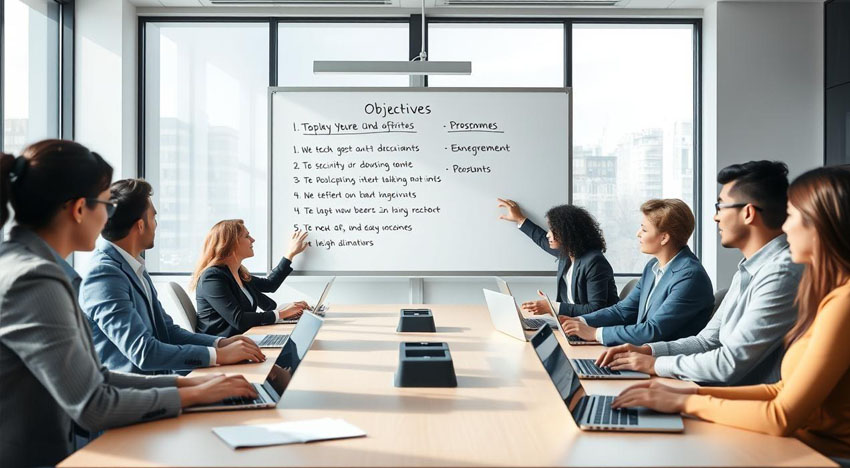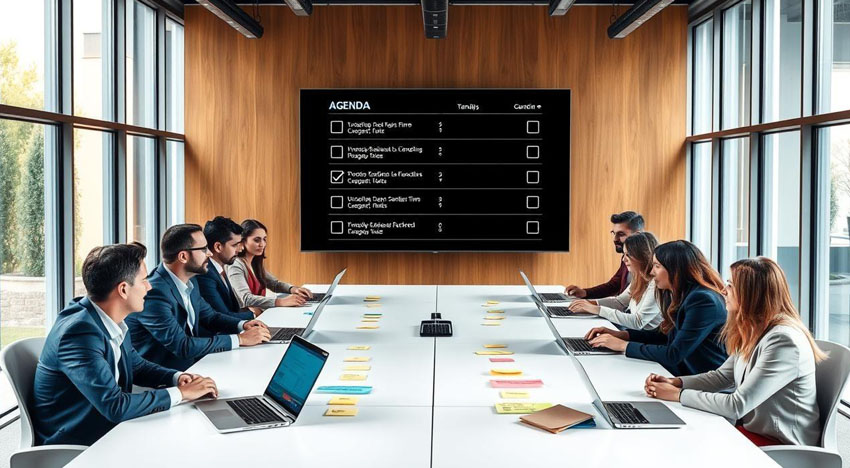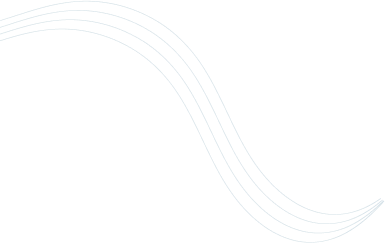Starting with clear, actionable meeting agendas is key to boosting sales team productivity. Studies show that well-planned meetings can make teams 20-30% more efficient. This guide will show you how to create agendas that not only bring your team together but also set them up for success.
Having no agenda can make sales leaders waste half of the meeting time. Realizing the importance of agendas is the first step to efficient meetings. Over 60% of salespeople see big improvements with a clear agenda, proving structured meetings boost productivity and teamwork.
Using a shared meeting agenda template cuts down preparation time by 25-40%. Also, sharing an agenda a day in advance makes 70% of participants feel more prepared. This guide offers tips for turning sales meetings into productive, goal-driven gatherings.
Key Takeaways
- Effective meeting agendas can boost productivity by 20-30%.
- Clear agendas prevent wasting up to 50% of participants’ time.
- Sales professionals observe significant improvements with defined agendas.
- Shared agenda templates reduce meeting preparation time by 25-40%.
- Participants feel more confident with an agenda shared 24 hours in advance.
- Defined meeting outcomes enhance decision-making by 40%.
- Consistent meeting planning increases team cohesion and effectiveness by 30%.
Understanding the Importance of Meeting Agendas
Discussing What is a Meeting Agenda? reveals its key role in increasing work efficiency. An average worker spends about 31 hours each month in meetings that don’t produce results. However, a well-planned agenda can save much of this wasted time. It sets the meeting’s goals, topics for discussion, challenges, time for questions and answers, and concludes the session. This structure gives a clear direction for meeting talks.
Teams with structured agendas see better involvement and work output. Meetings with clear aims improve readiness and accountability in team members. A survey found that 72% believe clear goals are vital for a successful meeting. Likewise, 67% say a defined agenda is important. Yet, meetings without good planning often last too long and go nowhere. This results in a huge cost of about $399 million annually to U.S. companies.
Consistent meetings set a routine that team members can expect. Using a standard agenda cuts down on wasted time. It makes meetings more efficient since everyone knows what to expect. Celebrations of achievements, updates on the sales process, and competitive insights top the list of effective meeting topics.

In sales meetings, focus on the entire team and goals instead of individual critiques to keep the mood uplifting. It’s crucial to involve everyone because bored team members won’t add value. Letting each person take turns making notes also helps keep everyone engaged. Additionally, showing examples of sales pitches allows for peer advice. This can make sales presentations better.
Answering What is a Meeting Agenda? correctly goes beyond staying on topic. It greatly improves meeting results, boosts efficiency, and makes every meeting worth the time.
Key Components of an Effective Agenda
An effective sales agenda boosts sales meeting productivity and smooth operation. It starts by setting specific objectives. This sets clear goals and makes meetings more actionable.
It’s key to define roles and responsibilities for clarity and accountability. This action prevents confusion by making sure everyone knows their role. It also leads to a more structured and effective meeting structure, which boosts engagement.
Assigning time slots to topics is crucial for pace and focus effective team meetings. This ensures discussions are on point and time is well-managed. All important issues get attention without dragging the meeting out.

Sales teams benefit from segmenting their agendas. This includes performance reviews, sales training and setting benchmarks. This approach has been shown to improve review quality by 60% and goal achievement by 25%.
Feedback shows 75% of salespeople want short, focused meetings. Focusing on key topics makes meetings more effective.
Open discussions about challenges can reveal solutions. This has increased problem visibility by 40%, making it easier to find and test solutions.
The right agenda does more than list topics. It’s about balancing setting specific objectives, clear roles, and good time management. This leads to meetings that are both productive and focused on goals.
How to Tailor Agendas for Sales Meetings
Making agendas for sales meetings boosts your team’s focus and productivity. Knowing your audience is key to a great sales meeting agenda. With specific weekly sales meeting goals and an eye on market trends, every meeting becomes meaningful.

Understanding your sales team’s needs is crucial. This knowledge helps make agendas that really speak to them. About 70% of sales teams find meetings unproductive because goals are not clear. A clear agenda cuts down off-topic talks by up to 30%.
SMART goals boost your team’s performance metrics by 25%. These goals should be specific and achievable. It’s smart to review past meetings. This keeps discussions focused, making them 60% more effective.
Market trends are essential in planning your meetings. Being up-to-date helps your team craft better sales strategies too. Almost all top sales teams use standard agendas for better focus and results. This method greatly improves efficiency and performance.
A good agenda outlines main points and clear actions, making more people show up next time by 50%. By knowing your audience and adding these points, you build a plan that keeps meetings on target and useful.
Strategies for Writing Clear Agendas
It’s crucial to create a clear agenda for your sales meetings. This ensures productivity and keeps your team on track. Simple language helps avoid confusion and boosts communication. According to a Harvard Business Review survey, this can lead to a 25% improvement in sales team members’ performance.

- Use Simple Language: Opt for straightforward language to ensure all participants understand the objectives and topics.
- Incorporate Visual Aids: Use graphs, charts, and other visual tools to highlight important data.
- Bullet Points for Clarity: Break down complex points into bullet points to make information easily digestible.
- Regular Reviews: Regular agenda reviews and updates help keep meetings relevant to current priorities and external changes.
A good agenda follows a structured format like this:
| Agenda Item | Time Allocation |
| Opening and Introductions | 5 minutes |
| Review of KPIs and Targets | 10 minutes |
| Pipeline Updates | 10 minutes |
| Addressing Roadblocks | 10 minutes |
| Strategy Discussion | 15 minutes |
| Action Items and Next Steps | 5 minutes |
| Q&A and Closing | 5 minutes |
Clear agendas improve communication and make every meeting productive. By updating and reviewing the agenda regularly, you can tackle new challenges and seize opportunities efficiently.
The Role of Technology in Agenda Creation
Technology is key in creating modern agendas, offering many tools for creating digital agendas. These tools help plan meetings better and improve teamwork. They make it easy for businesses to schedule meetings. This way, more people can attend.

Organizations see big pluses using AI-generated meeting agendas. AI agendas can cut meeting times by 30%, making discussions more focused. Teams with structured agendas are 40% more likely to meet their goals.
Using tools like Google Docs and Microsoft Teams allows people to add ideas before meetings start. This input makes the agenda cover all points of view.
AI tools analyze past meetings to highlight key topics. This makes action items 15% clearer after meetings and boosts engagement by 20%. Also, using AI makes decisions 25% better by using data.
| Technological Tool | Key Benefit |
| AI-Driven Agendas | 30% reduction in meeting time |
| Collaborative Platforms | Real-time team input |
| Scheduling Software (e.g., Doodle, Outlook) | Efficient meeting planning |
| AI Meeting Assistants | Improved meeting flow and engagement |
| Post-Meeting Follow-up Tools | Enhanced meeting outcomes |
Adding tech like video calls and data visualization improves meetings. Tools like Zoom keep remote members connected. Data tools help explain complex info easily.
In summary, tools for creating digital agendas have changed meeting management. From AI agendas to scheduling software, these tech advances help run meetings well. They lead to better results and happier employees.
Best Practices for Distributing Agendas
Distributing meeting agendas effectively can greatly improve your sales meetings’ productivity. It’s crucial to share the agenda on time. This sets the tone for a successful talk. Having a good agenda distribution strategy is key to your success stories keeping stakeholders involved and communicating well.

A study in 2019 showed that 67% of people find meetings distract them from work. Also, 34% said they lose 2 to 5 hours each week on unneeded meetings. So, it’s vital to send out detailed agendas early to avoid these issues.
Sending agendas early is the secret to a fruitful meeting. Make sure key stakeholders get the agendas ahead of time. This lets them get ready and know what will be discussed. Setting clear expectations this way leads to more effective meetings.
It’s also important to provide enough background when sending the agenda. Include relevant facts, history, or documents needed for preparation. This helps everyone understand the discussion points better, leading to smarter conversations. Clear goals, as noted in the 2019 study, improve team focus and understanding.
- Distribute agendas at least 48 hours before the meeting.
- Ensure all key stakeholders are included in the distribution list.
- Provide context and background materials to add clarity.
A solid agenda distribution strategy lays the groundwork for effective meetings. By focusing on timing, content, and communication, you’ll increase team involvement and success. This leads to better decisions and results.
How to Lead a Meeting with Your Agenda
Running meetings effectively needs a balance. It’s crucial to follow the agenda to stay on track. Yet, it’s just as vital to let everyone express their views. This ensures a meeting doesn’t go off course and waste time.

Leaders should blend three main skills:
- Adherence to the Agenda: Keeping to the agenda gives the meeting direction. It ensures all topics are covered within their time. This focus stops side-tracks and keeps everyone engaged.
- Encouraging Participation: Getting everyone to join in is key. Meetings with interactive discussions are known to produce 25% more ideas. This boosts the team’s performance significantly.
- Managing Time Effectively: Time is valuable. Sticking to the planned duration of a meeting shows respect. Half of the employees feel their time isn’t valued when meetings overrun, which can make them disengage.
An example agenda for Weekly Sales Team Meetings could look like this:
| Agenda Item | Duration |
| Sales Results Discussion | 5 minutes |
| Sales Activity Review | 10 minutes |
| Top Opportunities Discussion | 15 minutes |
| New Priorities and Initiatives | 10 minutes |
| Skills Development | 15 minutes |
| Recap of Priorities | 5 minutes |
Keeping meetings under one hour is ideal. This is crucial for the one on one meetings one-on-one sessions about individual performance. Clear objectives and following the agenda boosts engagement and productivity.
Leading a meeting well blends following the agenda, encouraging input, and time management. By sticking to these principles, sales managers can run effective meetings. This approach encourages a team environment next sales meeting that is both productive and collaborative.
Common Pitfalls to Avoid in Sales Meetings
Sales meetings are key to boosting productivity. But, some common pitfalls can reduce their effectiveness. By dealing with these issues directly, your meetings with sales representatives will be more productive and engaging.

One common mistake is overloading the agenda. Having too many topics can overwhelm attendees. This often leads to disengagement. The Trends in Sales Ops report shows that 72% of a seller’s time goes to non-selling tasks. A simpler agenda makes the meeting more focused and effective.
Here’s a summary of the main pitfalls:
- Overloading the agenda
- Forgetting to follow up
- Ignoring feedback
Addressing these pitfalls can greatly boost your sales meetings’ efficiency. Having a clear and structured agenda with follow-up plans and feedback integration boosts sales conversations and team productivity. It ensures meetings are engaging and compelling.
Keeping Agendas Flexible
Keeping your meetings’ agendas flexible is key to productive sales meetings. While a structured agenda boosts productivity by up to 35%, being too rigid can hinder creativity. It also limits how responsive you can be to sudden changes or urgent issues.

Changing your agenda can make your team more engaged and able to handle surprises. Teams that adapt their plans often do better at dealing with urgent matters, improving their responsiveness by 20%. Being open to sudden ideas or strategies keeps the meeting fresh and aligned with the business’s current needs.
Here are some strategies for keeping your meeting agendas flexible:
- Prepare for Adjustments: Be ready for unexpected changes. Set aside some time in your meeting to deal with surprises.
- Encouraging Open Communication: Make room for impromptu talks so team members can share their thoughts and worries. This boosts engagement by 30%.
- Revise Future Agendas: Use feedback from your meetings to tweak future plans. This helps your agendas stay useful and aligned with your targets.
- Incorporate Time for Wins: Start by celebrating recent achievements to lift team spirit by 15%. Keeping this part of the meeting flexible helps maintain focus on important tasks.
Measuring your meetings’ outcomes is crucial. Aim to improve future meetings’ agendas based on these results. Teams who track their progress can see a 20% boost in reaching their goals. Adding clear CTAs at the end of each meeting enhances the follow-up, making your agenda more effective and boosting sales.
Remember, being flexible doesn’t mean being unorganized. A meeting agenda that’s both adaptable and structured is the best way to encourage both planning and creative problem-solving.
Measuring the Results of Your Meetings
Knowing how well your own sales reps’ meetings are doing is vital. In firms that set goals, the value of meetings jumped by 32%. This shows how important it is to have clear aims. Plus, when companies use AI to help with meetings, people join in 18% more.
“Clear objectives and action items at the end of each meeting lead to more productive outcomes and improved accountability among participants.”

It’s smart to use feedback systems to check on what happens after meetings. Users of Supernormal finish up over 94% of their to-dos. This approach really makes meetings better. And when meetings go well, everyone feels more part of the team.
- Detailed Notes: Bad meetings cost companies $37 billion a year. That’s a lot of wasted money.
- Virtual meetings are still in. They show us that having a clear plan keeps everyone on track.
Figuring out if meetings hit the mark means looking at the right measures. For example, using tools to keep meetings on track kept 62% of them on schedule. Good metrics cover everything from how happy people are with meetings to how they boost the business.
| Metric | Outcomes |
| Meeting Relevance Score | 32% Improvement with Goal Setting |
| Meeting On-Schedule Rate | 62% Improvement with Analytics Tools |
| Attendee Participation | 18% Increase with AI Assistants |
| Meeting Satisfaction Score | Average 73% in Leading Organizations |
| Business Throughput | 25% Higher with Effective Benchmarks |
Getting input from your team and checking on tasks after meetings is key. By using analytics for meetings, you make sure goals and tasks are clear. This leads to meetings that get things done and hold everyone accountable.
Continuous Improvement of Meeting Agendas
To improve meeting agendas, get feedback from those who attend. Make clear goals to boost the meeting’s success and engage members by 25%. A well-planned agenda can cut meeting time by 30%, focusing on important discussions. Feedback helps tweak agendas so they stay on point and effective.

Keeping up with trends, like adding interactive parts, can spark 40% more ideas in meetings. Sharing agendas before meeting boosts readiness, making contributions 50% more useful. Using tracking tools improves task completion by 20% after meetings.
It’s key to adapt agendas as the team needs change. Time management cuts meeting lengths by 20%, raising productivity without losing quality. Encouraging everyone to join in can increase involvement by 35%, creating a committed team environment.
Having a feedback system is crucial for enhancing agendas. Regular feedback lets you make needed changes, keeping agendas up-to-date with both team and industry standards. A solid feedback process brings immediate betterment and more effective meetings.
Here are tips for better meeting agendas:
- Always ask for feedback from those attending the meetings.
- Look at the feedback to find common improvement areas.
- Change agendas based on the latest trends and team changes.
- Use tools to keep track of progress and clear goals.
- Have meetings to check how well current agendas are working.
FAQ
What is a Meeting Agenda, and why is it important?
A meeting agenda is a plan for discussions. It keeps things on track. This makes meetings organized and time well used. It helps everyone focus and prepare. This means meetings are more productive and goals are clear.
What are the key components of an effective meeting agenda?
An effective agenda has clear goals, roles, and times set. Goals make the meeting’s purpose clear. Roles keep everyone knowing what to do. And time limits keep talks focused.
How can I tailor agendas specifically for sales meetings?
To make agendas for sales meetings, know what your team needs. Add sales goals and discuss market trends to stay ahead. Craft messages and sales skills that hit the mark, focusing on strengths and improving weaknesses.
What strategies can I use to write clear and effective meeting agendas?
Use simple language in agendas for clarity. Add visuals and lists for easy reading. Update agendas to stay current. This keeps the agenda useful and in line with team goals.
How does technology enhance the creation and distribution of meeting agendas?
Technology offers tools for making and sharing agendas online. It helps plan meetings and lets teams give input anytime. This makes preparing and running meetings easier and more interactive.
When is the best time to distribute meeting agendas?
Send agendas out weekly team meeting early. This lets everyone prepare well. Make sure all key people get it to improve decisions. Early sharing sets clear expectations, making meetings more effective.
How do I effectively lead a meeting using an agenda?
Stick to the agenda to keep weekly meeting on track. Encourage everyone to join in. Manage time well. This makes sure the meeting is productive and hits its targets.
What are some common pitfalls to avoid when creating sales meeting agendas?
Avoid making agendas too full, forgetting to follow up, and ignoring feedback. Tackling these issues makes sales meetings work better.
Why is flexibility crucial for meeting agendas?
It’s good to follow the agenda, but be open to changes. This makes room for new ideas. Update agendas based on what happens and feedback. This keeps them useful.
How can I measure the success of my meetings?
Set clear success metrics. Get and look at feedback. Check on actions taken after. This helps understand the meeting’s impact and how to improve.
What are the best practices for continuously improving meeting agendas?
Keep looking for feedback and stay up-to-date with best practices. Adjust to team changes. Being open to change keeps your agendas effective and relevant.
How can a well-crafted agenda drive productivity in sales meetings?
A good agenda sets clear goals, manages time well, and covers topics fully. It leads to better prep, efficient meetings, and strong outcomes. This boosts productivity and aligns the sales team meeting agenda with sales targets.
References
- How to build better sales meeting agendas that get results – https://www.avoma.com/blog/prepare-effective-meeting-agenda
- The Essentials of Crafting Effective Sales Meeting Agenda + Examples – https://www.showell.com/resources/essentials-of-effective-sales-meeting-agenda
- The vital role of meeting agendas in business meetings – https://www.joinassembly.com/blog/the-purpose-of-meeting-agenda-productivity-and-efficiency
- Motivational Sales Meeting Ideas & Examples – https://www.pipedrive.com/en/blog/sales-meeting
- Essential Elements of a Successful Sales Meeting Agenda | Mailchimp – https://mailchimp.com/resources/sales-meeting-agenda/
- 10 Secrets To a Successful Sales Meeting Agenda – https://www.salesforce.com/blog/10-secrets-to-a-successful-sales-meeting-agenda/
- Sales Meeting Agenda: 10 Topics To Cover – https://mailshake.com/blog/sales-meeting-agenda/
- How to Create a High-Impact Sales Meeting Agenda | Grain Blog – https://grain.com/blog/how-to-create-a-high-impact-sales-meeting-agenda
- How to Plan and Run Productive Sales Meetings [+Free Sales Meeting Agenda] – https://meetgeek.ai/blog/sales-meetings
- Sales Meeting: Practical Tips, Agendas, and Best Practices – https://krisp.ai/blog/sales-meeting/
- How to Structure a Sales Meeting Agenda that Gets Results – https://www.close.com/blog/sales-meeting-agenda
- How to Properly Write an Agenda for a Meeting | UnSpot – https://unspot.com/blog/how-to-create-a-meeting-agenda-to-boost-team-productivity/
- Spinach | The Ultimate Guide to AI-Powered Staff Meeting Agendas – https://www.spinach.ai/blog/staff-meeting-agenda
- How can you design a meeting agenda that incorporates technology to enhance the experience? – https://www.linkedin.com/advice/1/how-can-you-design-meeting-agenda-incorporates-sefte
- Exploring AI Generated Meeting Agendas | Fellow.app – https://fellow.app/blog/meetings/ai-generated-meeting-agendas/
- Effective Sales Meeting Agenda: Proven Tips & Strategies – https://www.callpage.io/blog/posts/effective-sales-meeting-agenda
- How to run effective best sales meeting agenda in 15 minutes? – https://www.instaminutes.com/blog/how-to-run-effective-best-sales-meeting-agenda-in-15-minutes
- Running Efficient Sales Meetings: 7 Best Practices – Bubbles – https://www.usebubbles.com/blog/running-sales-meetings
- Ultimate Guide to Running High-Impact Sales Meetings – https://sbigrowth.com/sales-meeting-guide
- 9 Tips for a Productive Sales Team Meeting – https://www.nutshell.com/blog/how-to-hold-a-sales-team-meeting
- What Is Sales Data? – https://www.salesforce.com/sales/team-productivity/sales-productivity-pitfalls/
- 6 Barriers to Effective Sales Team Meetings and How to Avoid Them – https://kodiakgroup.com/2022/06/20/6-barriers-effective-sales-team-meetings-avoid/
- 9 Tips for Better Sales Meeting Agendas – https://www.letsdive.io/blog/9-tips-for-better-sales-meeting-agendas
- 8 steps on how to create an effective sales meeting agenda – https://www.getaccept.com/blog/sales-meeting-agenda
- 11 Sales Meeting Agenda Templates | ClickUp – https://clickup.com/blog/sales-meeting-agenda-templates/
- Meeting Analytics: How to Run Productive Meetings and Measure Their Success – https://www.supernormal.com/blog/meeting-analytics
- How to measure the impact of your meetings | SurveyMonkey – https://www.surveymonkey.com/mp/meeting-impact/
- How To Run An Effective Sales Meeting | Eric.ai – https://www.eric.ai/blog/how-to-run-an-effective-sales-meeting
- 7 Elements of a Sales Meeting Agenda: How to Win Sales – https://www.get1page.com/post/elements-of-sales-meeting-agenda
- Proven Strategies for Running Effective Sales Meetings – https://www.mortonkyle.com/effective-sales-meetings-high-performance-teams/
- Effective Meeting Agendas with Examples – https://notejoy.com/resources/meeting-agenda-example
- How to prepare for a Sales meeting – https://www.bluedothq.com/blog/how-to-prepare-for-a-sales-meeting
- How to Run Effective Sales Meetings | Mailchimp – https://mailchimp.com/resources/sales-meeting/







